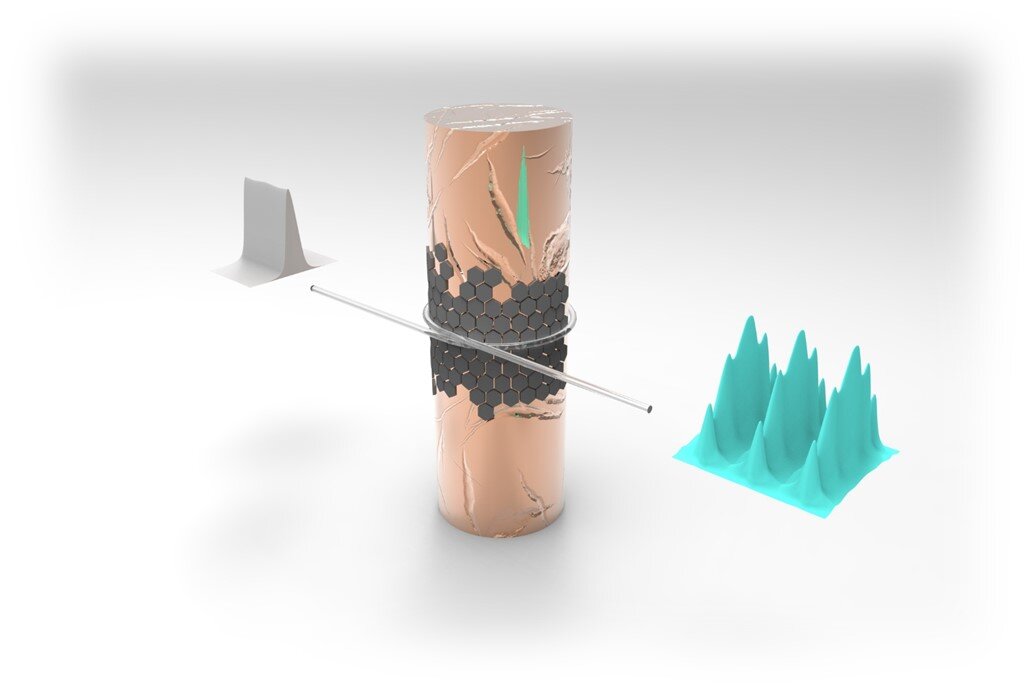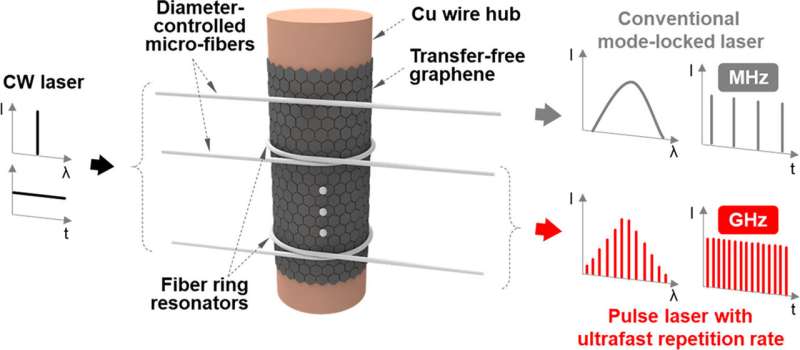
[ad_1]

Abstract illustration. Credit: Korea Institute of Science and Technology (KIST)
Pulsed lasers emit light repeatedly for a short time as if blinking. They have the advantage of focusing more energy than a continuous wave laser, the intensity of which remains unchanged over time. If digital signals are loaded into a pulsed laser, each pulse can encode one bit of data. In this regard, the higher the repetition rate, the greater the amount of data that can be transmitted. However, conventional fiber optic based pulsed lasers have generally had a limitation in increasing the number of pulses per second above the MHz level.
The Korea Institute of Science and Technology (KIST) announced that the research team led by principal investigator Dr. Yong-Won Song at the Center for Optoelectronic Materials and Devices was able to generate laser pulses at a rate at least 10,000 times higher than the state of the art. This achievement was accomplished by inserting an additional resonator containing graphene into a pulsed fiber optic laser oscillator that operates in the femtosecond domain (10-15 seconds). Data transmission and processing speeds are expected to increase dramatically by applying this method to data communications.
The KIST research team noted that the characteristics of the wavelength and intensity of laser light that change over time are correlated (Fourier transform). If a resonator is inserted into the laser oscillator, the wavelength of the pulsed laser is periodically filtered, thereby changing the pattern of change in intensity of the laser. Based on this basic research, lead researcher Song synthesized graphene, which has the characteristics of absorbing and eliminating weak light and amplifying the intensity by passing only strong light through the resonator. This allows the change in laser intensity to be precisely controlled at a high frequency, and thus the pulse repetition frequency could be increased to a higher level.

Graphene (Gf) was synthesized directly on the surface of a copper wire which acted as a hub for the diameter controlled microfibers (DCMF) to form the ring resonator. The Gf layer is physically in contact with the DCMFs for the nonlinear interaction with fully minimized damage. The classic Gf mode locking scheme without a ring resonator is compared to the proposed scheme. Additionally, scalability to multi-channel operation is described. Credit: Korea Institute of Science and Technology (KIST)
Additionally, graphene is typically synthesized on the surface of a catalytic metal, then the product is separated from the catalyst and transferred to the surface of a desired substrate. In this process, there has usually been the problem that the graphene is damaged or that impurities are introduced. The aforementioned KIST research team solved the problem of reduced efficiency occurring during the manufacturing process by forming graphene directly on the surface of a copper wire, which can be easily obtained, and further coating the wire with an optical fiber for its use as a resonator.
As a result, it was possible to achieve a repetition frequency of 57.8 GHz, thus overcoming the limitations of pulsed lasers in terms of repetition rate, typically constrained to MHz. Additionally, the characteristic of graphene such that heat is generated locally when the laser is absorbed has been exploited to tune the characteristics of the graphene resonator by applying an additional laser to the device.
KIST researcher Seong-Jae Lee said, “In the current scenario, in which the demand for data traffic increases exponentially, ultra-fast pulsed lasers operating at very high speeds and admitting tuning characteristics should provide a new approach to adapt to this rapidly changing data processing scenario. Principal investigator Song, who led this research, added, “We anticipate that the development of ultra-fast pulsed lasers based on resonators and graphene will bring our lead in technology development and the related market in the field of devices. optical information based on nanomaterials. ”
A new approach to achieve stable and high repetition rate laser pulses
Sungjae Lee et al, graphene auto-phase-lockers formed around a copper wire hub for ring resonators incorporated in pulsed 57.8 Gigahertz fiber lasers, ACS Nano (2020). DOI: 10.1021 / acsnano.0c07355
Provided by the National Research Council of Science & Technology
Quote: Optical data transmission speed increased by a factor of at least 10,000 (2021, January 20) retrieved on January 20, 2021 from https://phys.org/news/2021-01-optical-transmission-factor.html
This document is subject to copyright. Other than fair use for private study or research purposes, no part may be reproduced without written permission. The content is provided for information only.
[ad_2]
Source link